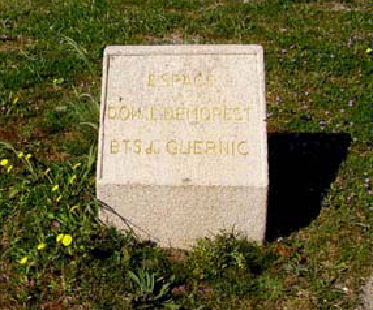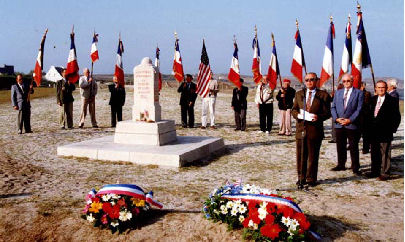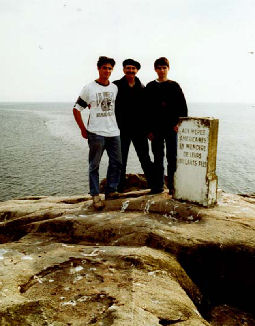Site réalisé par Jean-Michel Rocard
(les trois dernières photos données par André Guillevic)Portivy, July , 2006
(For comments: jmrocard@voila.fr and andre.guillevic@voila.fr.
Le monument - Mémorial franco-américain dédié aux Mères des Soldats américains morts pour la France pendant la Grande Guerre (1914-1918). Situé dans la presqu'île de Quiberon, tout près de sa célèbre "Côte Sauvage"
Le Fozo, Portivy, Saint Pierre Quiberon, Morbihan, FRANCE
Franco-American Memorial dedicated to the Mothers of American Soldiers who died during World War I
Located in Brittany, France (address above)
Near Portivy Harbour, ground given by L. Demorest for the transfer of la Borne de Guernic from the islet to the mainland
Près du port de Portivy: "Espace, Don L. Demorest, BTS de GUERNIC"
The Memorial Deblaize was erected in memory of the 117 000 American Soldiers who fell beside our POILUS in 1917 - 1918. It is dedicated to their Mothers and samples of earth, honoured by their blood, from the battlefields
The sacrifice of the 530 000 D1B who came to liberate us in 1944 - 1945 is a reminder of that of their predecessors
La stèle (mémorial) Deblaize, située actuellement au Fozo, Portivy (SPQ 56) mais installée dans l'ilôt de GUERNIC en 1931. Inscription: "Aux Mères Américaines en Mémoire de leurs vaillants Fils" (voir ci-dessous les explications).
The Franco-American memorial (sculptor G. Deblaize), now located at Le Fozo, Portivy (SPQ 56), was installed on the "Guernic islet" in 1931. (see below the explanations!)
Copie du certificat expédié depuis Paris à la Mairie de Saint-Pierre Quiberon le 22 août 1931par le Colonel PICOT, Président de l'Union des Blessés de la Face - "Les Gueules Cassées":
Le Colonel PICOT, Président des "Gueules Cassées" Commandeur de la Légion d'Honneur, certifie avoir confié au délégué Albert JUGON, Chevalier de la Légion d'Honneur, Médaille militaire, Croix de Guerre, douze petites Bornes françaises, en céramique bleu horizon (signées du sculpteur, créateur de l'œuvre G. DEBLAIZE, croix de guerre) renfermant une parcelle de Terre sacrée, prélevée sur les champs de bataille de la Grande Guerre dans les secteurs de l'AISNE - ARTOIS - ARGONNE - ALSACE - BELGIQUE - CHAMPAGNE - FLANDRES - LORRAINE - MARNE - SOMME - VOSGES et VERDUN, avec mission de les remettre, le 23 août 1931, à quinze heures sur le récif de Guernic, au Général MARIAUX, gouverneur des Invalides, Grand Officier de la Légion d'Honneur, qui les déposera solennellement dans la Borne Commémorative, dédiée aux Mères Américaines.
Ces douze Bornes de Terre Sacrée des champs de bataille seront placées dans les siècles, sous la garde vigilante des valeureux marins de Portivy.
Signé: Colonel PICOTEn septembre 1997, lors de l'inauguration du transfert au Fozo; à droite Le Maire de St-Pierre Quiberon, Jean-Michel Kervadec, puis André Guillevic et Dr Tacher
In September 1997, during the Fozo inauguration; the three persons on the right are the Mayor of St-Pierre Quiberon and two collaborators.
Copy of the certificate addressed from Paris to the St-Pierre Quiberon city hall on August 22, 1931 by Colonel PICOT President of the Association 'The Broken Faces" (State-approved):
Paris, August 22, 1931
Colonel Picot, the President of the "Broken Faces", Commander of the Legion of Honour, certifies that he has entrusted to Albert Jugon, Chevalier of the Legion of Honour (who has been awarded both the Military Medal and the Military Cross), twelve small French boundary stones of sky blue ceramic (the work of the sculptor G. Deblaize who had been awarded the Military Cross). These contain samples of Saced Earth from the battlefields in the areas of: AISNE - ARTOIS - ARGONNE - ALSACE - BELGIQUE - CHAMPAGNE - FLANDRES - LORRAINE - MARNE - SOMME - VOSGES and VERDUN. He was commissioned to hand them over on August 23, 1931, at 3:00 pm, on the reef of Guernic, to General MARIAUX, the Governor of the Invalides, Grand Officer of Legion of Honour, who will solemnly put them in the Memorial Boundary Stone, dedicated to the American Mothers.
Those twelve boundary Stones of Sacred Earth from the Battlefields shall for ever be entrusted to the vigilant care of the brave seamen from Portivy
Signed: Colonel PICOT
La photo suivante montre la stèle lorsqu'elle était installée sur l'îlot inhabité du Guernic. Pourquoi avoir choisi cet îlot qui fait face au fort de Penthièvre, lui-même à l'entrée de la presqu'île de Quiberon? Parce que des Bornes de Terre Sacrée (semblables) se trouvaient et se trouvent toujours d'une part au cimetière militaire d'Arlington (Washington, USA) et d'autre part à Saint-Louis des Invalides (Paris, France), les autorités civiles et militaires de l'époque ont choisi le point d'intersection de l'arc de cercle terrestre passant par Paris et Washington avec la côte française de l'Atlantique. Ce point se trouve au voisinage de l'entrée de la presqu'île de Quiberon. Le déplacement du Mémorial de Guernic sur le continent à Portivy a été effectué en 1997 lorsque M. Jean-Michel Kervadec (photo précéédente) était Maire de Saint-Pierre Quiberon.
The next picture represents the monument standing on the inhabited small island of Guernic. Why was that islet facing the Penthièvre fortress at the entrance to the Quiberon peninsula chosen? Because similar Boundary Stones are still set in Arlington's military cemetery (Washington, U.S.) and in the chapel of St-Louis des Invalides (Paris, France). At the time the civil and military authorities chose the point of intersection of the arc of terrestrial circle passing through Paris and Washington with the French Atlantic coast. That point is precisely near the entrance to the Quiberon peninsula. The removal of the Guernic memorial to Portivy on the mainland was carried out in 1997 when Mr Jean-Michel Kervadec was the mayor of Saint-Pierre Quiberon.
Sur l'îlot du Guernic, en juin 1994, 2 jeunes Bretons entourant un G.I. américain Ray Moon
On the islet of Guernic, in June 1994, 2 young Bretons surrounding an ex-G.I. "Ray Moon"
The last photo represents a painting by John Paul Jones (hanging in the hall of the Naval Academy, Annapolis Md) titled First Recognition of the Stars and Stripes
As a matter of fact, France was the first Nation to do the honours to the flag of the United States of America. This took place on February 14, 1778 in the bay of Quiberon (off the coast near Port Haliguen. (French squadron commanded by Admiral La Motte Piquet)La dernière photo est celle d'un tableau qui se trouve dans le hall de l'Académie Navale Américaine (Annapolis, Md, U.S.A.) intitulé "Première Reconnaissance du Drapeau américain".
Une stèle est d'ailleurs installée à Port Haliguen pour rappeler cet "événement". On peut lire:
A
PORT HALIGUEN
Le 14 Février 1778
La FRANCE représentée par
L ' escadre de la Motte piquet
fut la première nation
a rendre les honneurs
au pavillon des u.S.A.For your information: there is a link to a picture of the Franco-American Memorial, taken on September 18, 2001; click on :
http://bodoc.net/learn/rocardpages.htm and then on Black September, Septembre noir
Merci à Jean-Michel Kervadec, André Guillevic et Dr Joseph Tacher pour leur aide et leurs encouragements.
Post-Sriptum
Suite à une cérémonie de dépôt d'une gerbe de blé au Mémorial franco-américain (B.T.S, Borne de Terre Sacrée du Guernic) qui a eu lieu au Fozo le 19 août 06, l'Association des Amis de Gaston Deblaize m'a montré des manuscrits du sculpteur relatant l'historique des Bornes de Terre Sacrée qu'il avait conçues et réalisées à la demande d'une Association d'Anciens Combattants américains (Borne d'Arlington 1929, Autorisation du Ministère de la Défense U.S.) à sa propre initiative (BTS, St Louis des Invalides 1930; BTS du Guernic août 1931; Autorisation du Présisent de la République G. Doumergue) puis également à son initiative à =
- Meures (Haute Marne) Octobre 1931 quand il ajoute au symbole de la Terre Sacrée honorée par le sang des "Poilus" morts pour la France celui du Blé
- Cinq Mars La Pile (Indre -et-Loire) 1933, en hommage au Général américain DUNLAP (qui avait accompagné le Général Pershing en 1917 et est mort accidentellement dans ce village où il vivait depuis la fin de la Guerre)
- Ajaccio (Corse 1934), en hommage aux Corses morts pour la France et en particulier à son ami corse mort sous ses yeux à Verdun pendant les combats.
Le manuscrit de ce Sculpteur fera l'objet d'un site internet très prochainement.
Tout ce qui a été écrit ci-dessus est correct à une exception près: Ce ne sont pas les autorités civiles et militaires de l'époque qui ont choisi l'îlot du Guernic mais bel et bien Gaston Deblaize avec les autorisations du Maire de Saint- Pierre Quiberon, du Président de la République Gaston Doumergue et du Ministre des Anciens Combattants. D'après ce document tous ces monuments ont été l'œuvre d'un seul homme et offerts par lui en hommage aux Morts de la première Guerre Mondiale. La Borne du Guernic a été spécialement dédiée "Aux Mères Américaines" parce que Gaston Deblaize pensait aux mères américaines qui venaient se recueillir en mémoire de leurs fils morts sur les champs de bataille de la Guerre 14-18.
Post-Scriptum
After the August 19, 2006, Comemorative Ceremony during which a sheaf of wheat was placed at the Franco-American Memorial (The Guernic Sacred Earth Boundary Stone), the Gaston Deblaize's Friends Association showed me some notes of the sculptor; they related the history of the Sacred Earth Boundary Stones he had conceived and made at the request of an Association of U.S. Veterans; in 1929, he was authorized to make the Arlington boundary stone by the U.S. Secretary of Defence; in 1930, he made one for St Louis des Invalides Chapel on his own initiative; then in August,1931, he was authorized to make one on Guernic island by the President of the French Republic, Gaston Doumergue; on his own initiative again he made one in Meures (Haute Marne) in October 1931; he added then to the symbol of the Sacred Earth honored by the blood of the "Poilus" killed in action that of the WHEAT.
He made another one (1933) in Cinq Mars la Pile (Indre -et-Loire) as a tribute to the U.S. General DUNLAP who had come along with General Pershing in 1917 and died in an accident in that village where he had been living since the end of World War I.
Finally, in 1934, he made one in Ajaccio (Corsica) in homage to the Corsicans killed in action and particularly to his Corsican friend who had died before his very eyes in Verdun.
All that was written above is accurate except for one detail: the civil and military local authorities of that time did not choose the islet of Guernic but Gaston Deblaize did as he was authorized to by the Mayor of Saint-Pierre Quiberon and by President Doumergue and The Minister for War Veterans. According to this manuscript, all those monuments were undertaken by one man alone and offered by him as a tribute to the men killed in the First World War.
The Guernic Boundary Stone was specially dedicated to the "American Mothers" because Gaston Deblairze had in mind the American Mothers who did come and meditate on the battle fields where their sons had died during World War I.






